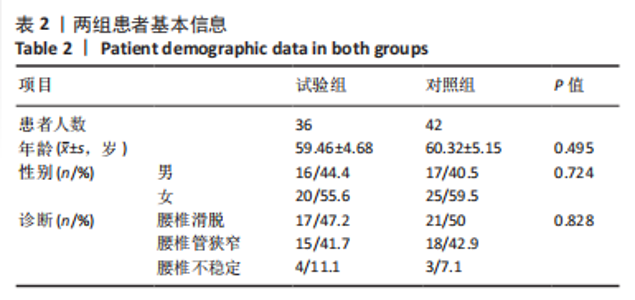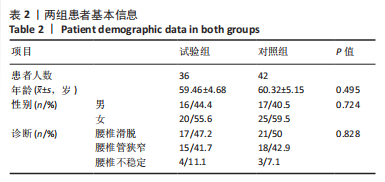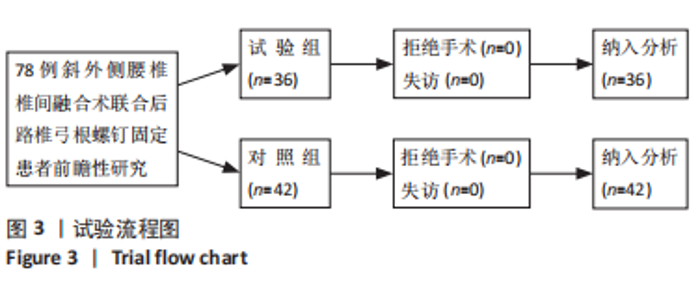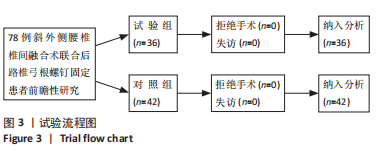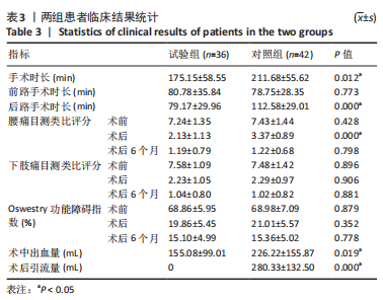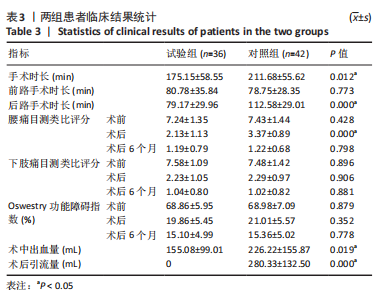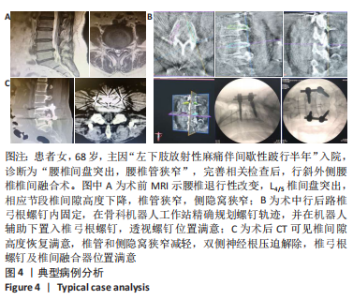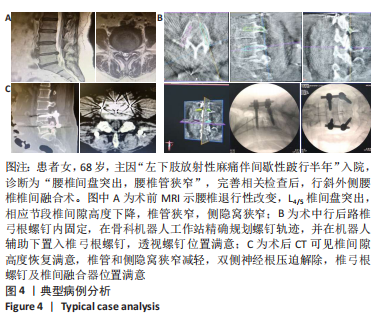[1] MOBBS RJ, PHAN K, MALHAM G, et al. Lumbar interbody fusion: techniques, indications and comparison of interbody fusion options including PLIF, TLIF, MI-TLIF, OLIF/ATP, LLIF and ALIF. J Spine Surg. 2015; 1(1):2-18.
[2] 中华医学会骨科学分会脊柱外科学组.腰椎斜外侧椎间融合术的临床应用指南[J].中华骨科杂志,2020,40(8):459-468.
[3] 张鲫.中老年病人腰椎管狭窄外科治疗策略及围手术期间风险预防[D].沈阳:中国医科大学,2013.
[4] 张大鹏,强晓军,王振江. P-POSSUM评分系统在骨科老年患者手术风险评估中的临床应用[J].中国医药导刊,2015,17(12):1202-1204, 1211.
[5] SILVESTRE C, MAC-THIONG JM, HILMI R, et al. Complications and Morbidities of Mini-open Anterior Retroperitoneal Lumbar Interbody Fusion: Oblique Lumbar Interbody Fusion in 179 Patients. Asian Spine J. 2012;6(2):89-97.
[6] 钟华璋,田大胜,周云,等.斜外侧椎间融合技术的研究进展[J].中华骨科志,2018,38(1):46-52.
[7] 张宇轩,王洪立,宋健,等.手术机器人在脊柱外科的应用进展[J].中华骨科杂志,2017,37(24):1556-1560.
[8] AOUDE AA, FORTIN M, FIGUEIREDO R, et al. Methods to determine pedicle screw placement accuracy in spine surgery: a systematic review. Eur Spine J. 2015;24(5):990-1004.
[9] 林云志,方国芳,李修往,等.半自动脊柱手术机器人系统在脊柱外科治疗中的应用[J].中国组织工程研究,2020,24(24):3792-3796.
[10] 杨睿,李勇奇,张柯,等.天玑骨科机器人辅助椎弓根螺钉置入的临床应用及体会[J].实用骨科杂志,2019,25(10):892-897.
[11] 茅剑平,孙宇庆,田伟,等.机器人辅助与徒手置入椎弓根螺钉在经椎间孔腰椎椎间融合术中的对比研究[J].中国微创外科杂志, 2019,19(6):481-484,489.
[12] Mehren C, Korge A. Minimally invasive anterior oblique lumbar interbody fusion (OLIF). Eur Spine J. 2016;25(Suppl 4):471-472.
[13] 宋红芳,张雯,张强,等.融合与非融合稳定方式对损伤性腰椎活动影响的对比[J].中国组织工程研究,2017,21(31):4963-4968.
[14] PANCHMATIA JR, VACCARO AR, WANG W, et al. Lumbar Percutaneous Pedicle Screw Breach Rates: A Comparison of Robotic Navigation Platform Versus Conventional Techniques. Clin Spine Surg. 2020;33(4): E162-E167.
[15] 杨俊松,郝定均,刘团江,等.脊柱机器人与透视辅助下经皮植钉治疗腰椎滑脱症中植钉精度的对比研究[J].中国修复重建外科杂志,2018,32(11):1371-1376.
[16] 崔冠宇,田伟,何达,等.机器人引导下微创经椎间孔椎体间融合术和传统开放手术治疗腰椎滑脱症的疗效分析[J].中华外科杂志, 2017,55(7):543-548.
[17] 姜树东,任龙喜,郭函,等.单侧减压机器人辅助微创经椎间孔腰椎间融合治疗影像学双侧腰椎管狭窄[J].中国组织工程研究,2020, 24(24):3797-3802.
[18] OHTORI S, ORITA S, YAMAUCHI K, et al. Change of Lumbar Ligamentum Flavum after Indirect Decompression Using Anterior Lumbar Interbody Fusion. Asian Spine J. 2017;11(1):105-112.
[19] FUJIBAYASHI S, HYNES RA, OTSUKI B, et al. Effect of indirect neural decompression through oblique lateral interbody fusion for degenerative lumbar disease. Spine (Phila Pa 1976). 2015;40(3): E175-182.
[20] BUDU A, SIMS-WILLIAMS H, RADATZ M, et al. Comparison of Navigated versus Fluoroscopic-Guided Pedicle Screw Placement Accuracy and Complication Rate. World Neurosurg. 2020;144:e541-e545.
[21] BORCEK AO, SUNER HI, EMMEZ H, et al. Accuracy of pedicle screw placement in thoracolumbar spine with conventional open technique. Turk Neurosurg. 2014;24(3):398-402.
[22] CHAN A, PARENT E, NARVACAN K, et al. Intraoperative image guidance compared with free-hand methods in adolescent idiopathic scoliosis posterior spinal surgery: a systematic review on screw-related complications and breach rates. Spine J. 2017;17(9):1215-1229.
[23] LAU D, TERMAN SW, PATEL R, et al. Incidence of and risk factors for superior facet violation in minimally invasive versus open pedicle screw placement during transforaminal lumbar interbody fusion: a comparative analysis. J Neurosurg Spine. 2013;18(4):356-361.
[24] 侯广原,张继学,张志军,等.骨水泥强化椎弓根螺钉内固定治疗伴骨质疏松腰椎退行性疾病的1年随访[J].中国组织工程研究, 2021,25(6):878-883.
[25] HUANG M, TETREAULT TA, VAISHNAV A, et al. The current state of navigation in robotic spine surgery. Ann Transl Med. 2021;9(1):86.
[26] PHAN K, MOBBS RJ. Oblique Lumbar Interbody Fusion for Revision of Non-union Following Prior Posterior Surgery: A Case Report. Orthop Surg. 2015;7(4):364-367.
[27] SCHMIDT FA, LEKUYA HM, KIRNAZ S, et al. Novel MIS 3D NAV Single Step Pedicle Screw System (SSPSS): Workflow, Accuracy and Initial Clinical Experience. Global Spine J. 2021:2192568220976393.
[28] TIAN W, FAN MX, LIU YJ. Robot-assisted Percutaneous Pedicle Screw Placement Using Three-Dimensional Fluoroscopy: A Preliminary Clinical Study. Chin Med J (Engl). 2017;130(13):1617-1618.
[29] KIM HJ, LEE SH, CHANG BS, et al. Monitoring the quality of robot-assisted pedicle screw fixation in the lumbar spine by using a cumulative summation test. Spine (Phila Pa 1976). 2015;40(2):87-94.
[30] VAN DIJK JD, VAN DEN ENDE RP, STRAMIGIOLI S, et al. Clinical pedicle screw accuracy and deviation from planning in robot-guided spine surgery: robot-guided pedicle screw accuracy. Spine (Phila Pa 1976). 2015;40(17):E986-991.
|
